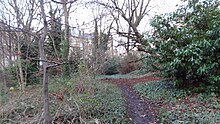
The London Borough of Islington is short of large parks and open spaces, given its status in recent decades as a desirable place of residence. In fact, Islington has the lowest ratio of open space to built-up areas of any London borough. The largest continuous open space in the borough, at 11.75 hectares, is Highbury Fields.

Stanmore Country Park is a 30.7-hectare (76-acre) public park, Local Nature Reserve and Site of Metropolitan Importance for Nature Conservation in Stanmore in the London Borough of Harrow. It is owned and managed by Harrow London Borough Council.

Stanmore Common is a 49.2-hectare public park, Local Nature Reserve and Site of Metropolitan Importance for Nature Conservation in Stanmore in the London Borough of Harrow in England. It is owned by Harrow Council and managed by the council with a local group. It was a biological Site of Special Scientific Interest, but was de-notified in the early 1990s.

Maryon Wilson Park is a public park in Charlton, in the Royal Borough of Greenwich in south east London. It is bounded on its northwest side by Thorntree Road; its southern-most, and highest, point is a gateway on to Charlton Park Road.

Oak Hill Wood is a 10-hectare Local Nature Reserve (LNR) and a Site of Borough Importance for Nature Conservation Grade I, in East Barnet, London. It is owned by the London Borough of Barnet, and part of it is a 5.5-hectare nature reserve managed by the London Wildlife Trust.

Jubilee Country Park is a 62-acre (25 ha) public park in Petts Wood in the London Borough of Bromley. It is a Local Nature Reserve and a Site of Metropolitan Importance for Nature Conservation. It was purchased by Bromley Council to celebrate the Silver Jubilee of Queen Elizabeth II in 1977, and opened as a park in 1981.
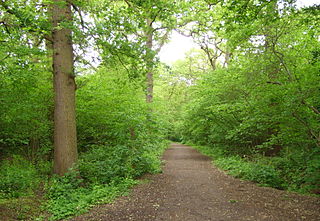
Big Wood and Little Wood are two patches of woodland in Hampstead Garden Suburb in the London Borough of Barnet. They are a Site of Borough Importance for Nature Conservation, Grade 1, and a Local Nature Reserve. Big Wood is 7.3 hectares and Little Wood is 1.2 hectares.
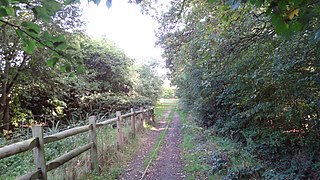
Ainslie Wood is a 2.03 hectares Local Nature Reserve and a Grade I Site of Nature Conservation Interest surrounded by urban housing in Chingford in the London Borough of Waltham Forest in England. It is owned by Waltham Forest Borough Council and operated by the council with Friends of Ainslie and Larks Woods.

Cranham Brickfields is an 8.5 hectare Local Nature Reserve and a Site of Borough Importance for Nature Conservation, Grade I, in Cranham in the London Borough of Havering. It has an area of woodland with a pond, wildflower meadows, and a grassed area with a children's playground. The site was formerly used for excavating clay to make bricks, and during the Second World War vegetables were cultivated as part of the Dig for Victory campaign. Wildlife includes bullfinches, great crested newts, stag beetles and green hairstreak butterflies. There is also dyer's greenweed, which is rare in London.

Cranham Marsh is a 15.3 hectare Local Nature Reserve and a Site of Metropolitan Importance for Nature Conservation in Cranham in the London Borough of Havering. It is owned by Havering Council and managed by the Essex Wildlife Trust.
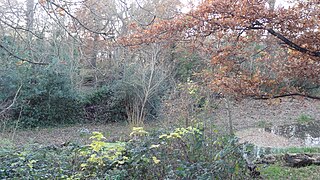
Dacres Wood is a small local nature reserve in Forest Hill in the London Borough of Lewisham. It is owned and managed by Lewisham Council.

Fishpond Wood and Beverley Meads is a 5.8 hectare local nature reserve adjacent to Wimbledon Common in the London Borough of Merton. It is owned and managed by Merton Council.
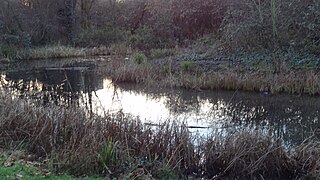
Gillespie Park is a 3.4 hectare Local Nature Reserve and Site of Metropolitan Importance for Nature Conservation in Highbury in the London Borough of Islington. It also hosts the Islington Ecology Centre, which provides environmental education for schools and organises walks and talks for adults. It is owned and managed by Islington Council. The site is protected by Fields in Trust through a legal "Deed of Dedication" safeguarding the future of the space as public recreation land for future generations to enjoy.
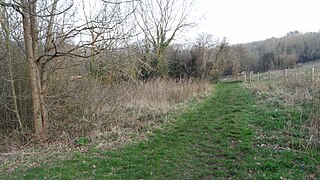
Foxley Wood is an 11.36 hectare Local Nature Reserve and Site of Borough Importance for Nature Conservation, Grade 1, in Purley in the London Borough of Croydon. It is owned and managed by Croydon Council. The site was purchased by Coulsdon and Purley Urban District Council under the Green Belt Act in the 1930s.
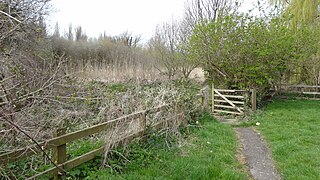
Spencer Road Wetlands is a one hectare Local Nature Reserve in Mitcham in the London Borough of Sutton. It is owned by Sutton Council and managed by the London Wildlife Trust.

Wilderness Island is the 2.7 hectare island between the Wandle and Wrythe in Carshalton in the London Borough of Sutton. It is designated a Local Nature Reserve and a Site of Metropolitan Importance for Nature Conservation, is owned by Sutton Council and is managed by the London Wildlife Trust.
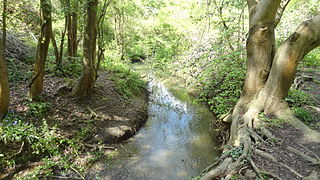
Castle Hill is a 3.5-hectare (8.6-acre) scheduled monument, local nature reserve and Site of Borough Importance for Nature Conservation, Grade 1, in Chessington in the Royal Borough of Kingston upon Thames, London. It is owned by Merton College, Oxford, and leased to Kingston Council. The site is managed by the Lower Mole Countryside Management Project.

Fox Wood is a 2.25 hectare Local Nature Reserve and Site of Borough Importance for Nature Conservation, Grade 1, in Ealing in the London Borough of Ealing. It is owned and managed by Ealing Council.
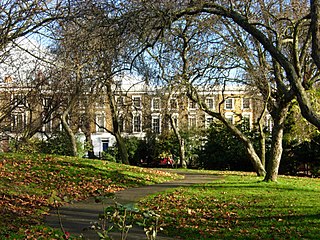
Thornhill Square together with the adjacent Thornhill Crescent form a garden square in the Barnsbury district of Islington, North London. It is bounded by Victorian terraced houses, all of which are listed buildings. The central public gardens contain flower beds, mature trees, and a children's play area, and the Crescent gardens surround the Victorian Church of St Andrew.
